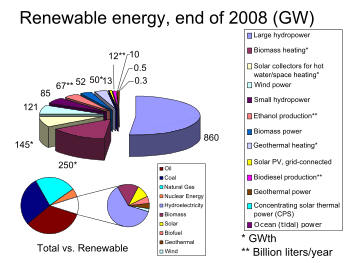 |
| English: Worldwide Renewable energy, existing capacities, at end of 2008, from REN21.http://www.ren21.net/globalstatusreport/g2009.asp Total energy is from BP Statistical Review.http://www.bp.com/statisticalreview (Photo credit: Wikipedia) |
Also discussed here: The Need for Jobs, and the Ecological Limits to Growth (Jeffrey M Doyle, Oct. 17, 2014)
Today we review a realistic short term plan for the USA that would comply with the IFCC objective to reduce world-wide greenhouse gas emissions by 40% from 2005 levels before 2035. It is based on making reductions in consumption of coal, oil, natural gas by 30-60% while assuming that the cost of renewable energy (hydro, wind, geothermal) will continue to decrease to the same levels as for carbon fuels by 2017. A carbon tax that would discourage carbon fuel use can produce public revenues of $ 200 B/year while avoiding economic impacts of $150 B/year if a 3 degree increase in earth temperature cannot be averted.
Key Quotes:
“The question for policymakers, and all other citizens, is no longer whether humans are changing our climate. The question now is, how we can stabilize an already changing climate in a way that promotes economic prosperity?”
"If a successful carbon tax or cap were implemented as part of this plan, it would also yield public revenues averaging $200 billion per year…if we were to assume that 75 percent of the revenues from a carbon cap or tax were returned directly to taxpayers, this would still leave roughly $50 billion per year to channel into supporting clean energy investments.
“A recent White House Council of Economic Advisors report found that a temperature increase of 3 degrees Celsius above pre-industrial levels would increase economic damages by $150 billion, year after year in perpetuity. “
“as of 2012 roughly 80 percent of all renewable energy consumed in the United States came from either bioenergy or hydro power…the average cost for producing electricity from most clean renewable sources—including wind, hydro, geothermal, and clean bioenergy—will be at rough cost parity with most nonrenewable sources by 2017”
“Some things should grow a lot, like the clean energy sector. Other things should shrink, like the fossil fuel sector. The growth from massive investments in clean energy will lead to millions of jobs.”
“To meet the 20-year emissions-reduction target, the following energy and economic policies are required:
- Reductions in fossil fuel consumption by approximately 60 percent for coal, 40 percent for oil, and 30 percent for natural gas
- Reduction of overall U.S. energy consumption by approximately 30 percent relative to current levels
- Raising overall U.S. energy production from low to zero emissions renewables by more than fourfold.
- Reduction in oil imports to absorb most of the decline in U.S. oil consumption…
- Transitional support”
- No expansion of nuclear energy supply”







No comments:
Post a Comment